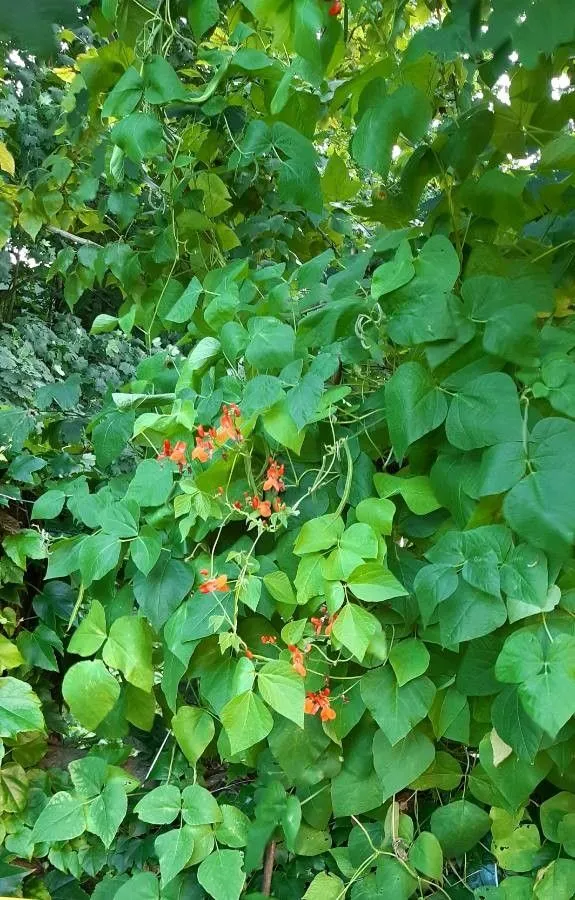
Author: L.
Bibliography: Sp. Pl.: 724 (1753)
Year: 1753
Status: accepted
Rank: species
Genus: Phaseolus
Vegetable: True
Observations: Mexico to C. America
The Runner bean, scientifically known as Phaseolus coccineus, is a fascinating plant renowned for its vibrant flowers and nutritious beans. Originating from Mexico and Central America, this species thrives in diverse climates, bridging the gap between decorative and edible gardening.
Belonging to the Fabaceae family, the Runner bean is celebrated both for its aesthetic appeal and its agricultural value. Its striking scarlet (or sometimes white) flowers not only add a splash of color to gardens but also attract beneficial pollinators, such as bees and hummingbirds. These pollinators, in turn, play a crucial role in the ecosystem by aiding the plant’s reproductive process.
The plant’s vigorous growth habit makes it an excellent choice for vertical gardening. When provided with a trellis or support, Runner beans can climb impressively, creating lush, green screens adorned with flowers throughout the growing season. This characteristic not only maximizes garden space but also makes the plant suitable for small garden plots and urban gardening scenarios.
Beyond its ornamental qualities, the Runner bean is cherished for its edible pods and seeds. Young pods can be harvested and eaten whole, offering a tender and flavorful vegetable for culinary use. As they mature, the beans inside can be dried and stored, providing a nutritious and protein-rich food source. The versatility of Runner beans in the kitchen is widely appreciated, making them a staple in many traditional dishes in their regions of origin and beyond.
The history of Phaseolus coccineus dates back to its initial classification in 1753, under the authorship of the renowned botanist Carl Linnaeus. This historical context highlights the plant’s long-standing presence and significance in horticulture and agriculture.
In summary, the Runner bean is a multifaceted plant that brings together beauty, utility, and ecological importance. Its origins in Mexico and Central America have bestowed it with a robust and adaptable nature, making it a beloved choice for gardeners and farmers alike.
Tur: bombay fasulyesi
Deu: feuer-bohn, feuer-bohne, feuerbohne
Fra: haricot d’espagne, haricot écarlate, haricot-fleur, haricot-d’espagne
Dan: pral-bønne
Eng: runner bean, scarlet runner, multiflora bean, runner-bean, scarlet runner bean, scarlet-runner-bean
Spa: cubá, frijol-chamborote, judía encarnada, judía pinta, pilay, ayocote
Ita: fagiolo die spagna
Ces: fazol šarlatový
Por: feijão-da-espanha, feijão-flor, feijão-trepador
Swe: rosenböna
Hun: török bab, tűzbab
Nld: pronkboon
Nob: prydbønne
Nno: prydbønne
Cym: ffa dringo, ffaen ddringo, ffeuen ddringo
En: Runner bean, Scarlet runner bean, Multiflora bean, Scarlet runner, Runner-bean, Scarlet-runner-bean, Perennial Bean, Cub, Haricot d’Espagne, Haricot á Fleurs Rouges, Runner Beans, Scarlet bean, Dutch Case-Knife Bean
Af: Nierboontijie
Hy: Կրակոտ կարմիր լոբի (Բազմագույն լոբի)
Eu: Babarrun loregorri
Be: Фасоля крывава-чырвоная
Ca: Mongeta vermella, Mongetera vermella
Zh: He bao dou, 荷包豆
Cs: Fazol šarlatový
Da: Pralbønne, Pral-bønne
Nl: Pronkboon, Slaboon
Eo: Fajrofazeolo
Fi: Ruusupapu
Fr: Haricot d’Espagne, Haricot écarlate, Haricot-fleur, Haricot-d’espagne, Haricot a Fleurs Rouges
Gl: Faba de tres anos
De: Feuerbohne, Arabische Bohne, Blumenbohne, Feuer-Bohne, Käferbohne, Schminkbohne, Stangenbohne, Türkische Bohne, Feuer-Bohn, Wollbohne
He: שעועית הרץ
Hu: Török bab, Tűzbab
Ga: Pónaire reatha
It: Fagiolo die Spagna, Fagiuolo americano, Fagiolo americano, Fagiolo rampicante di Spagna
Ja: Hana-sasage
Kk: Түрік бұршағы
Ko: Bulgeungangnamkong
Lt: Raudonžiedė pupelė
No: Prydbønne
Nb: Prydbønne
Nn: Prydbønne
Fa: لوبیای قرمز
Pl: Fasola wielokwiatowa
Pt: Phaseolus lunatus, Feijão-da-espanha, Feijão-flor, Feijão-trepador
Pt-br: Feijão-da-Espanha, Feijão-trepador
Ru: Фасоль многоцветковая
Sk: Fazuľa
Es: Judía encarnada, Judía pinta, Pilay, Cubá, Ayocote, Frijol-chamborote, Chamborote, Chilipuca
Sv: Rosenböna
Zh-tw: 荷包豆
Zh-hant: 荷包豆
Tr: Ateş fasulyesi, Bombay fasulyesi
Cy: Ffeuen ddringo, Ffa Dringo, Ffaen Ddringo
Taken Sep 11, 2022 by Fabrice Rubio (cc-by-sa)
Taken Sep 4, 2021 by Irmgard Groß (cc-by-sa)
Taken Sep 11, 2022 by Fabrice Rubio (cc-by-sa)
Taken Oct 3, 2022 by Fabrice Rubio (cc-by-sa)
Taken Sep 4, 2021 by Irmgard Groß (cc-by-sa)
Taken Sep 4, 2021 by Irmgard Groß (cc-by-sa)
Taken Aug 14, 2020 by Georg Rosenbaum (cc-by-sa)
Taken Sep 4, 2021 by Irmgard Groß (cc-by-sa)
Taken Dec 8, 2002 by Mieke van Galanthus (cc-by-sa)
Taken Sep 8, 2022 by Mike Fly (cc-by-sa)
Taken Oct 3, 2022 by Fabrice Rubio (cc-by-sa)
Taken Jul 5, 2021 by Manuëlle (cc-by-sa)
Taken Sep 4, 2021 by Irmgard Groß (cc-by-sa)
Taken Sep 5, 2022 by christophe giraudot (cc-by-sa)
Taken Sep 5, 2022 by christophe giraudot (cc-by-sa)
Taken Jul 5, 2021 by Manuëlle (cc-by-sa)
Taken Aug 22, 2019 by And Mil (cc-by-sa)
Taken Sep 15, 2020 by Dome0815 (cc-by-sa)
Taken Sep 4, 2021 by Irmgard Groß (cc-by-sa)
Taken Sep 5, 2022 by christophe giraudot (cc-by-sa)
© copyright of the Board of Trustees of the Royal Botanic Gardens, Kew.
© copyright of the Board of Trustees of the Royal Botanic Gardens, Kew.
© copyright of the Board of Trustees of the Royal Botanic Gardens, Kew.
Taken May 4, 2017 by Antoine AFFOUARD (cc-by-sa)
Taken May 4, 2017 by Antoine AFFOUARD (cc-by-sa)
Taken May 4, 2017 by Antoine AFFOUARD (cc-by-sa)
Taken May 4, 2017 by Antoine AFFOUARD (cc-by-sa)
Taken May 4, 2017 by Antoine AFFOUARD (cc-by-sa)
Taken Jul 15, 2013 by Photoflora – Benoit BOCK (©)
Taken Jul 10, 2022 by Lisa (cc-by-sa)
Taken Sep 15, 2008 by Photoflora – Jean-Luc TASSET (©)
Taken Aug 15, 1989 by Photoflora – Jean-Luc TASSET (©)
Taken Jan 1, 1800 by Tela Botanica − Daniel MATHIEU (cc-by-sa)
Growth habit: Vine, Forb/herb
Family: Myrtaceae Author: (F.Muell.) K.D.Hill & L.A.S.Johnson Bibliography: Telopea 6: 402 (1995) Year: 1995 Status:…
Family: Rubiaceae Author: Pierre ex A.Froehner Bibliography: Notizbl. Bot. Gart. Berlin-Dahlem 1: 237 (1897) Year:…
Family: Sapindaceae Author: Koidz. Bibliography: J. Coll. Sci. Imp. Univ. Tokyo 32(1): 38 (1911) Year:…
Family: Asteraceae Author: A.Gray Bibliography: Pacif. Railr. Rep.: 107 (1857) Year: 1857 Status: accepted Rank:…
Family: Fabaceae Author: Medik. Bibliography: Vorles. Churpfälz. Phys.-Ökon. Ges. 2: 398 (1787) Year: 1787 Status:…
Family: Aspleniaceae Author: (Cav.) Alston Bibliography: Bull. Misc. Inform. Kew 1932: 309 (1932) Year: 1932…